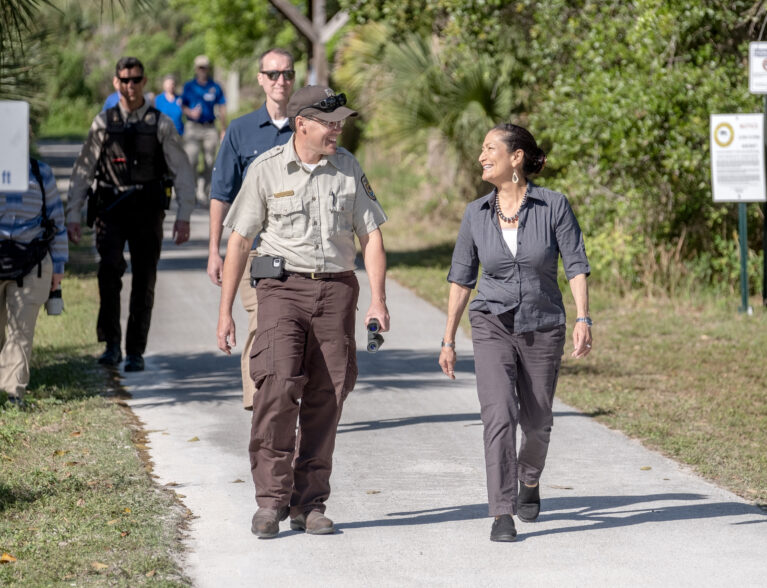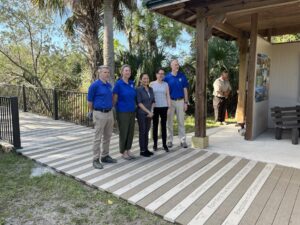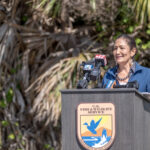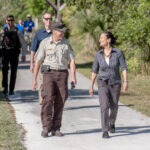
Pelican Island holds a special place in the history of protected lands across the nation. President Theodore Roosevelt created the first national wildlife refuge on March 14, 1903 at Pelican Island to protect brown pelicans from market hunters, according to U.S. Fish & Wildlife Service officials.

From left to right: U.S. Fish and Wildlife Regional Director of Mountain-Prairie Matt Hogan, U.S. Fish and Wildlife Director Martha Williams, Secretary of the Interior Deb Haaland, Assistant Secretary for U.S. Fish and Wildlife and Parks Shannon Estenoz and U.S. Fish and Wildlife Southeast Regional Director Mike Oetker pose for a photo on Monday, March 11, 2024, at the Centennial Boardwalk located at Pelican Island National Wildlife Refuge. PHOTO BY NICK SAMUEL
Now, the refuge system is expanding with a new addition – the four-million acre Everglades to Gulf Conservation Area located in southwest Florida. Monday, the Department of the Interior traveled to Pelican Island National Wildlife Refuge – the first of its kind in America – to announce the brand new 571st unit.
“I’m thrilled to be here with all of you as we celebrate the establishment of the Everglades to Gulf Conservation Area,” U.S. Secretary of the Interior Deb Haaland said. “I know that everyone loves a good birthday party. I could think of no better way to celebrate the National Wildlife Refuge System’s 121st birthday than right here at Pelican Island – the system’s birthplace – to commemorate the newest addition to this special network of lands and waters.”
Other federal officials who talked about the importance of land conservation included Assistant Secretary for Fish and Wildlife and Parks Shannon Estenoz, and U.S. Fish and Wildlife Service Director Martha Williams.
The visit came three days before the 121st birthday of the Pelican Island refuge and the National Wildlife Refuge System. Haaland, Estenoz and Williams, along with U.S. and Fish and Wildlife Southeast Regional Director Mike Oetker, laid down planks at the Centennial Boardwalk to highlight the new unit, along with three other conservation areas added to the refuge system within the past few years.
William “Popeye” Osceola, secretary of the Miccosukee Tribe based in the Everglades area, said “it’s a good day to be Indigenous.” The Miccosukee people – which predate explorer and navigator Christopher Columbus – were originally part of the Creek Nation and migrated to Florida before it became a U.S. state, according to tribal officials.
“Where we’re standing, this is the first wildlife refuge that was established. This land you see was shaped and stewarded by my ancestors. We used to gather resources here back in the day,” Osceola said. “We weren’t always feeling welcome on that land. So it’s really great to be here today with you folks.”
Haaland, a member of the Pueblo of Laguna Tribe and the first Native-American to serve as a Cabinet secretary, said the National Wildlife Refuge System plays an invaluable role in providing vital habitats for wildlife species, offering outdoor recreation access to the public and bolstering climate resilience across the country.
“I had the great privilege to visit many of our beautiful national wildlife refuges to see firsthand how they benefit the species and communities that surround them,” Haaland said as she spoke at a podium before a crowd of dignitaries and environmental enthusiasts. “I’ve planted trees with young students in San Diego, taken a bout tour in the amazing Okefenokee swamp in Georgia, bird watched at Valle de Oro in my home state of Albuquerque, New Mexico, and walked the boardwalk at Pocosin Lakes in North Carolina.”
The birthplace of national wildlife refuges
Pelican Island, along with the surrounding 5,400-plus acres of protected waters and lands, make up the birthplace of the National Wildlife Refuge System, federal officials said. Today, the Pelican Island refuge is among the most visited areas in Indian River County.
Three hiking trails lead nature lovers over mangrove-lined canals to an observation deck, where two free telescopes give a clear view of Pelican Island, the nesting area for brown pelicans. Pelican Island is among hundreds of land areas across the U.S. that were designated as National Wildlife Refuge Systems.
Pelican Island National Wildlife Refuge is located on North Hutchinson Island, northwest of Treasure Shores Park and west of Highway A1A. National wildlife refuges are managed by the U.S. Fish and Wildlife Service. The refuges protect thousands of species and provide access to world-class recreation, according to the agency’s website.
“Each and every visit to a national wildlife refuge has been unique and uplifting,” Haaland said. “They underscore why investing in our public lands is so, so important.”
Preserving lands and waterways
The Everglades to Gulf Conservation Area stretches from southwest Florida to the north. The area spans 12 counties, from Naples to Lakeland, Estenoz said.
The land is a habitat for a variety of species, including the Florida black bear, Everglade snail kite bird, Florida panther and sand skink lizard, along with more than 100 threatened or endangered species, federal officials said.
“This milestone we’re celebrating today will preserve this working landscape, provide wildlife linkages, address the biodiversity crisis and build resilience in the face of climate change not just for our kids, but for our grandkids and many generations to come,” Haaland said. Haaland said the collaborative move is central to President Biden’s “America the Beautiful” initiative, which aims to conserve and restore 30 percent of lands and waters by the year 2030.
Three other lands established in the refuge system under Haaland’s leadership are the Lost Trail Conservation Area in Montana added in 2022, Wyoming Toad Conservation Area added in 2023 and the Paint Rock River National Wildlife Refuge in Tennessee added in 2023.
The protected areas are national wildlife refuges that are made up of mainly conservation easements on private lands in partnership with landowners. A conservation easement is when agencies can purchase developmental rights to the land to keep the acreage in a rural setting.
“Conservation easements are a new and innovative approach to conservation,” said Kathy Burchett, refuge supervisor for Florida and the Caribbean. “You can’t turn (the land) into a condo. It has to stay in whatever the state of the land was at the time or better. We’re in the forever business of protecting land.”
The Everglades to Gulf Conservation Area combines public and private land protection opportunities, federal dignitaries said. The area, which is adjacent to the Everglades Headwaters National Wildlife Refuge and Conservation Area in Polk County, will help address concerns regarding the loss of wildlife, habitat, access to natural lands and waters along with water quality, federal officials said.
“The new Everglades to Gulf Conservation Area represents a tremendous opportunity for the U.S. Fish and Wildlife Service to work together with landowners, tribes, local communities, conservation and recreation stakeholders and the state of Florida to conserve important wildlife habitat and corridors, enhance recreation opportunities, preserve working agricultural lands and protect iconic watersheds,” Estenoz said.
Osceola said the new conservation unit was a sign of great progress.
“It’s not just for us to enjoy now. We have to think seven generations ahead,” Osceola said. “What is this place going to look like for those after us?”
Photos by Joshua Kodis
- Secretary Deb Haaland
- Secretary Deb Haaland
- Secretary Deb Haaland
- Secretary Deb Haaland at far right.










